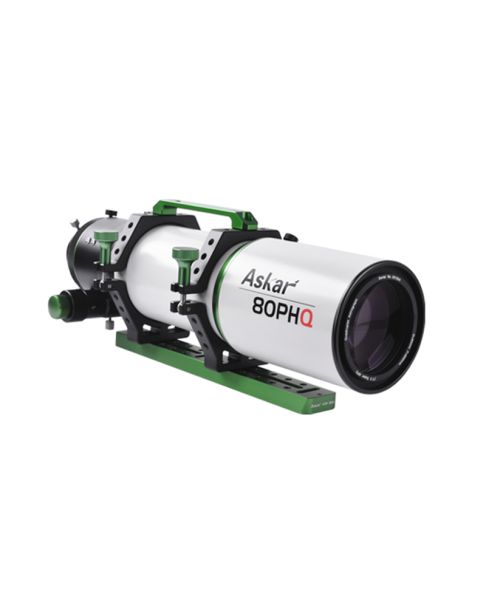Askar 80PHQ Quadruplet air-spaced APO astrograph
Askar 80PHQ Quadruplet air-spaced APO astrograph
Askar 80PHQ Quadruplet air-spaced APO astrograph
The overall finish of 80PHQ is evenly painted. The ivory and flawless coating of the main tube feels comfortably pimply, which can not only increase your grip, preventing the telescope from slipping off from your sweaty hands, but also improve its texture, avoiding the tedious monotony.
A pair of clamshell-style CNC-manufactured black tube rings tightly hold the OTA. So you can just turn two locking screws to loosen or tighten the tube rings simplifying the setup by avoiding the frequent use of small tools like Allen wrenches or socket head screws.
The bright green dust cap, handle, locking screws, focusing knob and decorative rings add more energy and vitality to the otherwise deep and profound astrograph. White and green is the classic combination for PHQ series.
There is a 3" rack-and-pinion rigorous focuser on the rear end of the telescope. It’s a smooth focusing unit with dual-speed adjustment. 80PHQ’s rotator is marked with precise graduation which makes your previous subjective adjustment more accurate.
80PHQ inherits the optical design of the PHQ- family, adopting a 3+1 quadruplet lens structure which contains two pieces of ED glass that can effectively reduce chromatic aberration and enhance clarity and sharpness. It’s worth mentioning that all astrographs from PHQ- family come with an integrated lens combination rather than simply placing three major lenses and a corrector together in a line. In another word, the whole optical system cannot solely perform without any piece of these lenses. This structure design leads to a more rational lens arrangement, better vignette control and superior image quality. The focal ratio of 80PHQ is f/7.5. It’s a “long” focal-ratio astrograph compared with other counterparts from Askar. It’s a little bit longer even compared with 107PHQ which is f/7 in focal ratio.
Some users may be frustrated that it’s hard to make a trade-off between 107PHQ and 80PHQ, since there seems to be so much in common. And especially for those who are new to astrophotography, the complicated designations and confusing numbers are really a major obstacle when they hopefully try to pick out just the proper one from oceans of dazzling products.
Indeed, 170PHQ and 80PHQ are similar in many aspects partially because they are both the newly-developed refractive astrographs from the same family. However even if they all have excellent mechanical design and sophisticated optical system, there are noticeable differences between these tw
- Aperture size:80mm
- Focal length:600mm
- Focal ratio:f/7.5
- Objective lens:Quadruplet air-spaced APO (including two ED glass)
- Image circle:44mm
- Maximum accessory connection (with the focuser fully retreated):
1. Imaging mode:
115mm(from the base of M48×0.75 male thread)
135mm(from the base of M54×0.75 male thread)
155mm(from the base of M68×1male thread)
168.5mm(from the base of M76×1 male thread)
2. Observing mode:
148mm(from the end of 2" eyepiece holder - Total length:450mm(including 1.25" eyepiece holder as dew shield contracted)
540mm(including 1.25" eyepiece holder as dew shield fully stretched)
480mm(including the 4-piece adapter as dew shield contracted)
570mm(including the 4-piece adapter as dew shield fully stretched) - Net weight:3.9kg
- Gross weight:4.7kg
- Rear-end thread type:M76×1-M68×1
M68×1-M54×0.75
M54×0.75-M54×0.75
M54×0.75-M48×0.75(M48×0.75 filter thread inside - Standard package items:an 80PHQ OTA,a pair of tube rings, a handle, an Askar 300mm Vixen dovetail plate, a set of 4-piece photographic adapters, a manual
| Product Status | New |
|---|---|
| Package width | 25 cm |
| Package height | 26 cm |
| Package depth | 60 cm |
| No. of parcels | 1 |




